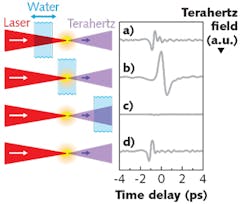Terahertz Sources: Femtosecond laser pulses produce ultrafast terahertz radiation from water

While terahertz radiation has been generated from solids, gases, and plasmas (the "fourth state" of matter) before, no one had created terahertz light from a liquid—until now. A group from the Institute of Optics at the University of Rochester (U of R; Rochester, NY), Huazhong University of Science and Technology (Wuhan, China), the Center for Terahertz Waves and School of Precision Instrument and Opto-electronics Engineering at Tianjin University (Tianjin, China), Capital Normal University (Beijing, China), and ITMO University (Saint Petersburg, Russia) has used the effects of femtosecond pulses on water to achieve this feat.1
"It is the first-time demonstration of intense and broadband terahertz-wave generation from liquid water," says X.-C. Zhang, professor at the U of R's Institute of Optics and one of the researchers.
Plasma from water
In the technique, 500 fs laser pulses at a 1 kHz repetition rate and a center wavelength of 800 nm are focused into a water film, creating a plasma within the film that produces terahertz pulses of about 60 fs duration. The incoming laser light is angled at 25° from the normal to minimize sputtering of water onto the optics.
Because water highly absorbs terahertz radiation (with an absorption coefficient of 220 cm-1 at 1 THz), the water film must be made very thin. This is done using a gravity-driven, free-flowing setup that produces a 177-μm-thick continuous and stable vertical film of liquid water in free space. This thickness, which can be adjusted by altering the water-flow rate, is calibrated and measured using an optical second-harmonic intensity autocorrelator, a method first developed by researchers at the Technical University of Denmark (Kongens Lyngby, Denmark) in 2014.2
Because a femtosecond laser focus in plain air can also generate terahertz output, the two potential outputs must be somehow separately measured. With the knowledge that water absorbs terahertz radiation, these outputs (from air and from water) can be separately measured by moving the water film axially through the laser's focal region (see figure).
The laser pulse energy excitation threshold to produce terahertz radiation was about 160 μJ. When the pulse energy was raised to higher than 420 μJ, the water film broke up.
To determine the dependence of the terahertz emission on the pulse duration, the researchers varied the frequency chip of the incoming optical pulse to produce differing terahertz pulse durations. The shortest pulse, 58 fs, was reached with no frequency chirp. However, the maximum field for the terahertz pulse occurred for longer pulse durations achieved via either a negative or positive frequency chirp (the direction of the chirp didn't make much of a difference). This behavior contrasts with that for terahertz production in air plasma, which produces its maximum field via the shortest pulse (no chirp).
The influence of polarization of the optical ultrafast pulses on the polarization of the resulting terahertz radiation was also studied. The optical polarization was rotated with a half-wave plate, while a wire-grid polarization analyzer was used to see the result on the terahertz beam. A p-polarized optical beam produced a much stronger terahertz output than did an s-polarized optical beam, with an approximate cosine-squared relationship between the p-polarized component of the terahertz field and the angle of the optical polarization.
The researchers believe their work will contribute both to the study of laser-liquid interactions and the creation of new terahertz sources.
REFERENCES
1. Q. Jin et al., Appl. Phys. Lett., 111, 071103 (2017); http://dx.doi.org/10.1063/1.4990824.
2. T. Wang et al., IEEE Trans. THz Sci. Technol., 4, 4, 425 (2014); doi:10.1109/tthz.2014.2322757.

John Wallace | Senior Technical Editor (1998-2022)
John Wallace was with Laser Focus World for nearly 25 years, retiring in late June 2022. He obtained a bachelor's degree in mechanical engineering and physics at Rutgers University and a master's in optical engineering at the University of Rochester. Before becoming an editor, John worked as an engineer at RCA, Exxon, Eastman Kodak, and GCA Corporation.